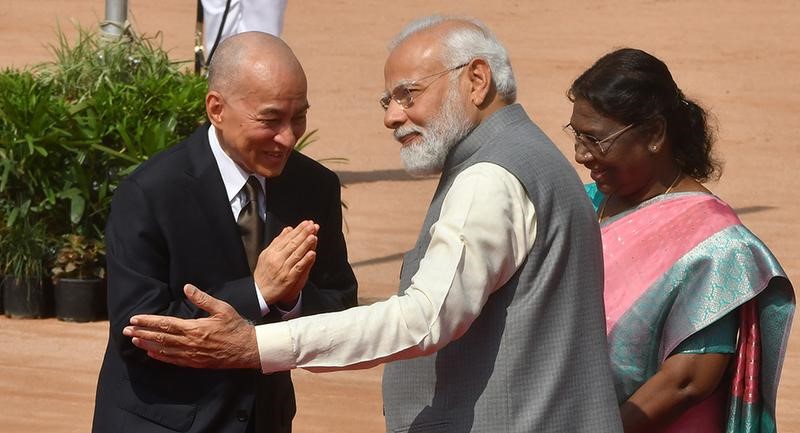Description

Disclaimer: Copyright infringement not intended.
Context
- Welcoming Preah Bat Samdech Preah Boromneath Norodom Sihamoni, the King of Cambodia, at Rashtrapati Bhavan, President said there is great potential for further growth in trade and investment between India and Cambodia.
- She said India is keen to further elevate its defence relations with the Southeast Asian country.
Background of relations
- Historically, India-Cambodia relations dates back to the beginning of C.E. or perhaps even before when Hindu and Buddhist religious and cultural influences emanated out of India to Cambodia & greater region of South East Asia.
- Cambodians are predominantly Buddhist but they retain a strong influence of Brahminical rituals and mythology.
- The magnificent structure of Angkor Wat temple, built between 12th to 14th centuries, is a glorious testimony of pervading influence of temple architecture of India.
- Indian influences are also seen on the earlier temples of Cambodia such as Preah Vihear dedicated to Lord Shiva built from late 9th century onwards, Angkor Thom, Bayon, Ta Phrom, Sambor Prei Kuk and other historical sites.
Political Relations
- In the 1950s, India was associated with the International Control Commission on Indo-China.
- India’s contribution as Co-Chairman of this Commission came in for widespread appreciation in Cambodia.
- After the collapse of the Khmer Rouge regime, India was the first country to recognize the new government and reopened its Embassy in 1981.
- India also responded to an appeal by the Cambodian Government to send a team of experts from Archaeological Survey of India in 1986 for the restoration of the famous Angkor Wat temple.
- There exists abundance of goodwill for India in Cambodia, which has been sustained by regular interactions of political leaders, exchange of bilateral visits, aid and assistance, capacity building, cultural exchanges, concessional loans for developmental projects and restoration and conservation of old temples in Cambodia.
- In the context of India’s ‘Act East’ policy and the ASEAN, Cambodia is an important interlocutor and a good partner.
- Contemporary times have witnessed expansion of cooperation in diverse fields such as institutional capacity building, human resource development and extension of financial assistance in infrastructure projects, social security projects and capacity building in defence.
- The bilateral relations have been reinforced by several high level visits. Post colonial era, Prime Minister Jawaharlal Nehru visited Cambodia in 1954.
- From Cambodian side, Prime Minister Hun Sen has visited India many times; also participated in the ASEAN-India Commemorative Summit and as Guest of Honour at the Republic Day Parade 2018 along with other ASEAN Leaders.


Assistance & Aid Projects
- India and Cambodia have signed various Agreements and MoUs in the fields of bilateral cooperation, trade & commerce, cultural exchanges, capacity building, concessional loans for developmental projects and restoration and conservation of old temples in Cambodia.
- Government of India had sent experts from Archaeological Survey of India for restoration and conservation of Angkor Wat temple from 1986-1993.
- Restoration of another temple complex at Ta Prohm has been a major ongoing project.
- In 2018, India committed to help part restoration of ancient temple of Preah Vihear.
- In the past, India had gifted medicines, rice, indelible ink to Cambodia.
- Lines of Credit have been extended for Water Resource Development, Transmission Line and Supply of water pumps.
- India also assisted in the project for redevelopment of India-Cambodia Friendship school in 2015.
- Under the Mekong Ganga Cooperation(MGC) initiative, India helped in establishment of the Asian Traditional Textile Museum at Siem Reap.
- India has been assisting Cambodia with small Socio-Economic projects known as Quick Impact Projects in the fields of agriculture, health, women empowerment, capacity building, sanitation, environment and information technology every year.
Defence
- The cooperation has been continuing in defence sector with the conduct of annual training capsule for Royal Cambodian Armed Forces in Peacekeeping and Demining modules; defence courses under ITEC; goodwill visits by Indian Navy and Indian Coast Guard ships and exchange of official delegations.
- India has also gifted fifteen sniffer dogs to Cambodia for demining activities.
Trade and Investment
- Although economic interaction between India and Cambodia is limited, the trade and investment figures have changed positively in recent years.
- India exported US $ 178.24 million worth of goods to Cambodia, showing 48.19 percent increasing in 2018 while imports valued at US $ 48.45 million, increasing by 0.90 percent in the same year.
- Total trade reached US $ 226.69 million in 2018, increased 34.69 percent as compared to 2017.
- On bilateral investment, India invested US $ 19.8 million in 2016.
- The economic relations between the countries are also facilitated by the Mekong-Ganga Cooperation and the ASEAN-India Free Trade Agreement.
Indian Diaspora in Cambodia
- The first Indians in modern times to settle in Cambodia arrived in the 1960s and 1970s.
- Most of them came from the Southern province of Tamil Nadu and they worked as jewelers, moneylenders and traders around Central Market in Phnom Penh.
- The Indians returned to Cambodia when Khmer Rouge was defeated.
- Indian population in Cambodia is though small in number but it remains an intimate and close-knit group that has integrated well into local society.
Cultural Relations
- India-Cambodia cultural and historical relations are more than a millennium old when Indian culture, religion and trade emanated out of India and spread rapidly in various parts of South-East Asia.
- However, Cambodia witnessed Indian influence centuries before that whose living example is the temples of Sambor Prei Kuk built by Ishanvarmana I and other kings of Chenla empire during 6thand 7th Century AD in Ishanapura, the then capital of the Kingdom, which is so far the oldest known example of existence of Indian culture and religion in Cambodia.
- However, some scholars are of the opinion that the cultural and religious connect between India and Cambodia date back to 1st
- According to Cambodian belief, Khmer people’s founding legend centers around an Indian prince Kaundinya called Preah Thaong in Cambodian folklore.
- Cambodian society which is now predominantly Buddhist retains a strong influence of Indian Hindu and Buddhist rituals, idolatry and mythology which can be seen in many of its rituals having resemblance with Indian culture and traditions.
- Khmer language too is a live example of Indian culture which has approximately more than 3000 words originated from ancient Indian Sanskrit language.
- Later the pervading influence of Hinduism, Buddhism, and Indian architecture are borne out by the magnificent structures at Angkor Wat, Angkor Thom, Bayon, Ta Prohm, Bantey Srei, Preah Vihear and other religious and historical sites in Cambodia.
MUST READ ARTICLES:
https://www.iasgyan.in/daily-current-affairs/cambodia
|
PRACTICE QUESTION
Q) Both India and Cambodia not only have old-age cultural and historical linkages but also are presently engaged in strengthening bilateral cultural relationship. Discuss. (250 words)
|

https://epaper.thehindu.com/ccidist-ws/th/th_delhi/issues/37892/OPS/G67B9UK5C.1+GA3B9VI4J.1.html












